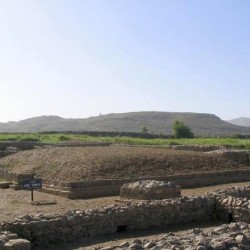Taxila, Sirkap's sanctuaries
Taxila (Old Indian Takshaçila, Greek Ταξίλα): the ancient capital of the eastern Punjab, the country between the rivers Indus and Hydaspes. The site consists of several parts, which belong to the Achaemenid, Greek, and Kushan periods.

The second city at Taxila is called Sirkap and was founded by the Bactrian king Demetrius, who conquered this region in the 180s BCE, and rebuilt by king Menander. Taxila's sanctuaries reflect the multicultural nature of the Indo-Greek kingdom, which consisted not only of the Punjab, but also of Gandara, (i.e., the valley of the Kabul and Swat), Arachosia, and a part of the Ganges valley.
"Contact between religions is good": this maxim of the Mauryan king Ashoka, which can be found in the twelfth of his famous rock edicts, was certainly a guideline to the rulers of Taxila, whether they were Indian, Greek, Parthian, Sacan, or Kushan. There were sanctuaries of several religions inside the city; only the Zoroastrians preferred to stay outside, at Jandial - but this may be accidental. In spite of this religious tolerance, the Buddhists always were the main religious group, and we find many stupas in Sirkap.

A stupa is a funeral mound, usually associated with the death and nirvana of Buddha. Many stupas in Gandara and the Punjab clearly show Greek artistic influences, as we will see below. This is not in unique; for example, it can also be seen in a very late, large stupa like the one at Shingerdar.

The building that is known as the "Apsidal Temple" is the largest sanctuary of Sirkap, measuring 70 by 40 meter (by contrast: the Parthenon in Athens is 70 by 31 meter). The Apsidal Temple consists of a square nave with several rooms, used by the Buddhist monks, and this circular room, which gives the building its apsidal shape.
After the earthquake that destroyed the city in c. 30 BCE, the Buddhist shrine was built in a spacious courtyard. The round part was probably in use for a small stupa, but no traces of it remain. Some carvings were probably done by an artist from Greece.
The next four photos show, from left to right: the Hindu temple of the Sun; a Jainist sanctuary that looks like a stupa; and two photos of the "Double-headed Eagle Stupa", which combines Buddhist traditions and Greek artistic elements. The moldings, cornice, pilasters, and pedimental niches might have been discovered in the hellenistic world too. The pilasters are of a Greek design, Corinthian columns.
 Sirkap, temple of the Sun |
 Sirkap, Jainist sanctuary |
 Sirkap, stupa of the double-headed eagle |
 Sirkap, stupa of the double-headed eagle |

On the fourth photo above, in the left arch, a Greek temple is shown; on the right, we see a shrine of a Hindu design. On top of these sanctuaries, a double-headed eagle is seated. The motive is rather odd, to say the least, as it is originally Babylonian, seems to have spread to Scythia, and was introduced in the Punjab by the Saca rulers.